Indiana is known for its vast farmland, but it also has forests, prairies, meadows, and marshes. All of these habitats make great homes for snakes. Out of 32 species, only four are venomous and may pose a threat to humans. If you are hiking through Hoosier National Forest and find a black snake sunning itself on a nearby rock, how can you tell what kind of snake it is? Out of fear, you might think it’s harmful based on coloration. In order not to confuse all black snakes with each other, we’ll look at some that are found in Indiana.
1. Cottonmouth (Water Moccasin)

Cottonmouths are sometimes called water moccasins. They are very rare in Indiana but are venomous snakes.
©jo Crebbin/Shutterstock.com
The cottonmouth, sometimes called the water moccasin, is a black snake in Indiana and also one of the four venomous snakes in the state. The four venomous snakes in Indiana are the cottonmouth, timber rattlesnake, eastern Massasauga rattlesnake, and eastern copperhead.
You can find cottonmouths in and around water like lakes, ponds, rivers, and marshes. In Indiana, they are very rare, so it is unlikely you would see one anywhere. If you see a black snake in the water, it is more likely a non-venomous water snake like the plain-bellied water snake.
Cottonmouths swim with their whole body floating on top of the water, whereas water snakes just have their head above water. If you come across an angry cottonmouth, you may get to see the inside of its white mouths as they flash their fangs at you. They do have a reputation for having a bad attitude and being aggressive, so it is safest to stay away from them.
2. Timber Rattlesnake
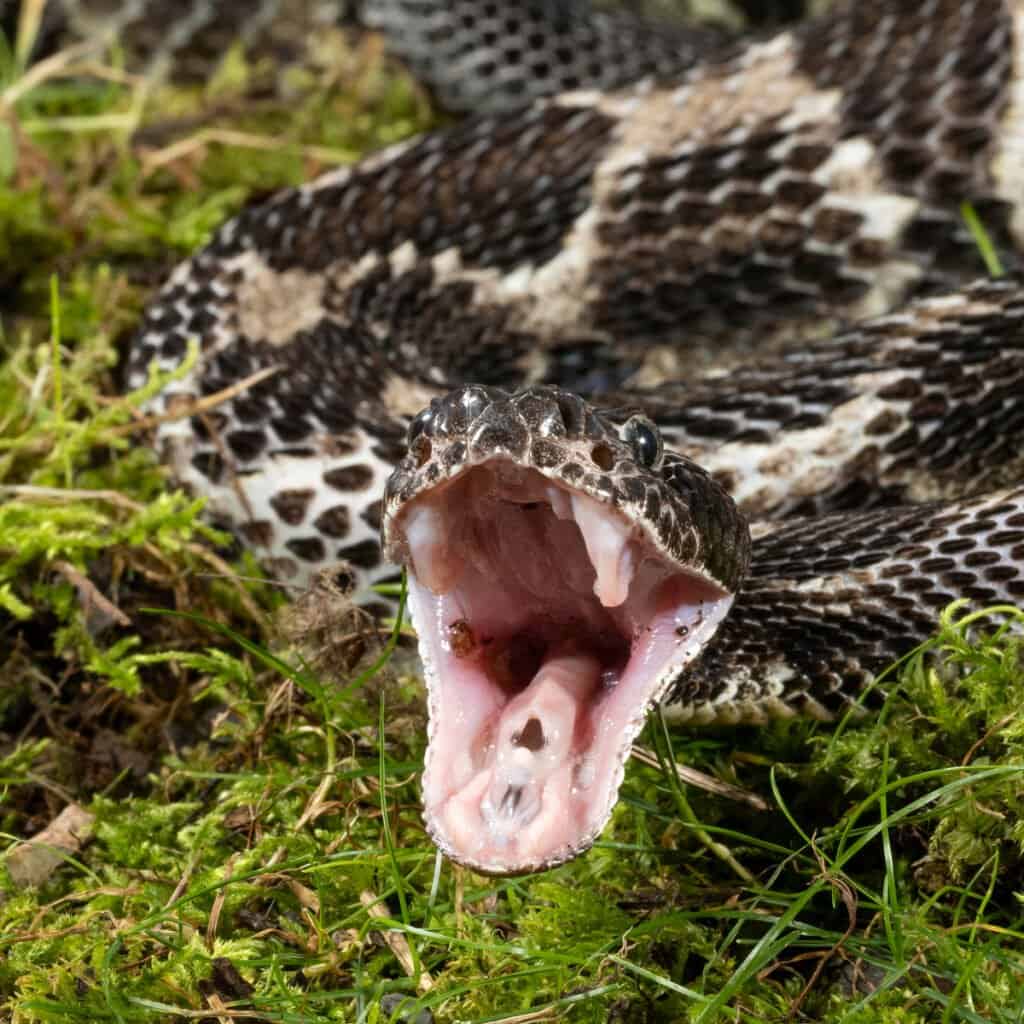
Timber
Rattlesnakes
are sometimes black with dark markings. They have large fangs and are venomous.
©Joe McDonald/Shutterstock.com
Timber rattlesnakes are a bit tricky. They are not always black – sometimes they are yellowish with dark brown markings, and other times, they are black with faint dark brown markings. As a rattlesnake, look for the rattle at the end of the tail and triangle head with openings on the side of the head (pits that help sense prey). If threatened, they may coil their body and raise their head before striking, so give them room. Timber rattlesnakes are not aggressive snakes and prefer to rely on their camouflage, remaining still until a threat leaves. They are 2.5-5 feet long and heavy-bodied. These snakes prefer forested areas but are only in a few counties in Indiana.
3. Black Kingsnake

Black kingsnakes are around 3-4 feet long and can kill venomous snakes!
©Matt Jeppson/Shutterstock.com
Black kingsnakes are all black with alternating black and white bars on their mouth (like piano keys). They are a medium-sized snake, about 3-4 feet long. Despite their size, they are not afraid to take on venomous snakes like the cottonmouth or timber rattlesnake. They seem to be immune to their venom. Black kingsnakes are found in southern Indiana near the edges of forests or along wetlands. The most likely place you would see one is crossing the road as it searches for food. Besides other snakes, kingsnakes eat small mammals like rats and mice.
4. Gray Ratsnake
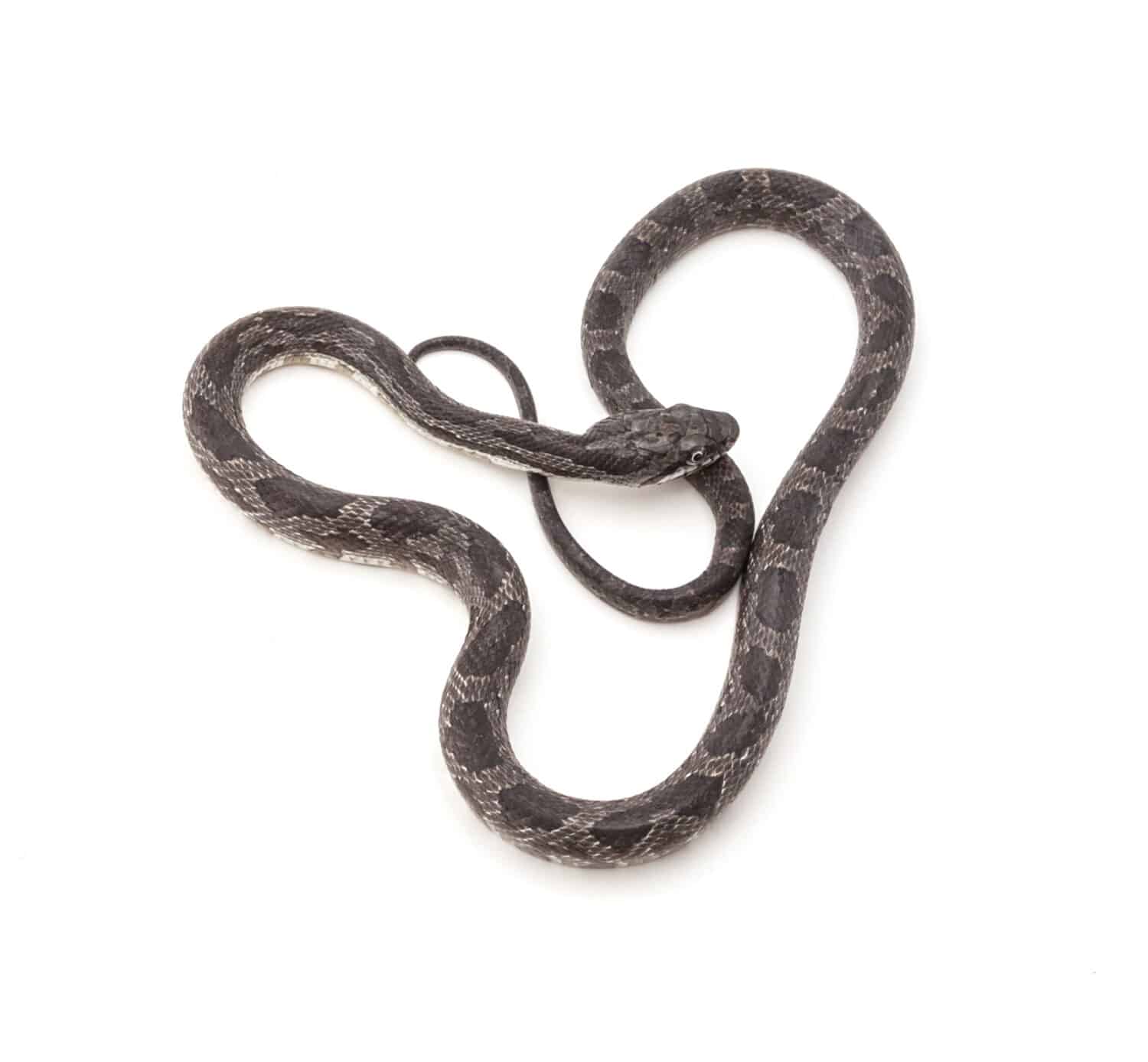
Gray ratsnakes usually keep their pattern throughout their lives.
©Melinda Fawver/Shutterstock.com
The name says “Gray,” but these snakes range in color from light gray to all black. They tend to get darker as they get older. Some have dark brown blotches along their back as well. The gray rat snake is the longest snake in Indiana. They are thick-bodied with a tail that gets skinnier as it gets to the end. Adult males are around 6 feet long, but some have been recorded at 8 feet! Your average sofa is 6-8 feet long — can you imagine a snake sprawled out on your sofa?! They are found throughout Indiana except for northwestern Indiana on the sand prairies. Instead of watching your step while you hike, you should look up to see if they are dangling from a nearby tree. They spend much of their time climbing trees and can even travel from tree to tree!
5. Eastern Racer

The eastern racer is the fastest snake in Indiana. They can get up to 4 mph for short bursts.
©Breck P. Kent/Shutterstock.com
Eastern racers are graceful and fast snakes. If you think you caught a slithering black snake from the corner of your eye, it was probably an Eastern racer. They can be all black or dark gray with white under their chin. Eastern racers in northwestern Indiana are more blue and have a black raccoon-like mask. Compared to other black snakes in Indiana, eastern racers are skinnier and have longer tails than most. They can get to be around 5 feet long. They are found throughout Indiana and prefer dry ground like open fields, meadows, and prairies. Since they come out during the day, they might be a snake you would run into. If threatened, they may charge at a person but then retreat before biting. That would certainly be enough warning for me to back away!
6. Red-Bellied Snake
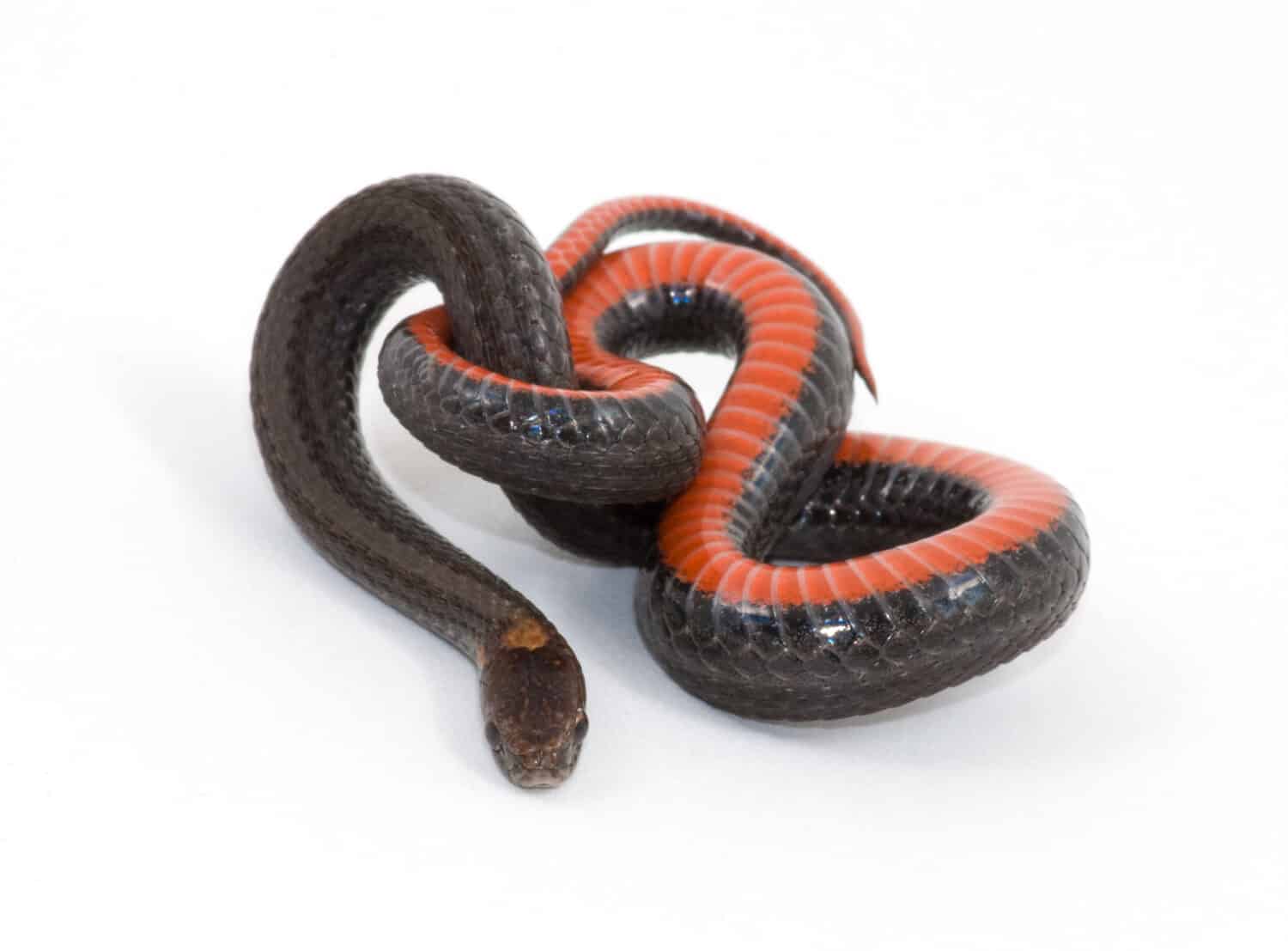
Red-bellied snakes are cousins to Dekay’s brown snake.
©Gerald A. DeBoer/Shutterstock.com
There are red-bellied snakes and red-bellied mudsnakes. We’ll address the red-bellied snake here. As their name implies, red-bellied snakes have red bellies. Their backs are all brown, with some being darker that look black. These are tiny snakes, with most being under a foot long. They are skinny as well —skinnier than your finger. These little snakes prefer to hide under logs, barks, and leaf piles, so it is less likely that you would see one out and about. They are found mostly in northern Indiana and could be in open prairies and savannahs.
7. Red-Bellied Mudsnake
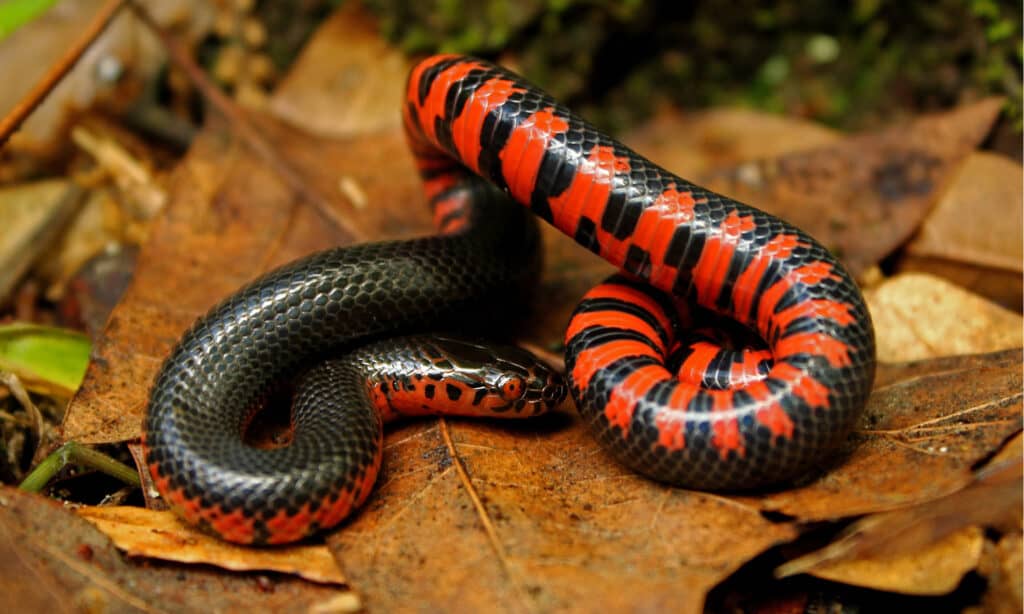
Red-bellied mudsnakes have distinct red and black markings on their bellies.
©Thesigner_2696/Shutterstock.com
You won’t get the two red-bellied snakes mixed up because the red-bellied mudsnake is quite a bit larger than the red-bellied snake. The mudsnake is around 1-4 feet long and has a black color on its back with bright red and black markings on its belly. The alternating red marks can be seen along the side of the snake, so they are easy to recognize. They prefer swampy areas and used to be in Indiana but are now rarely seen in the state.
8. Plain-Bellied Water Snake
Although they are called plain-bellied snakes, their bellies are actually bright red. They are sometimes called copper bellies. Their backs are all black with faint banding marks, and their bellies are all red, so they do look different from the red-bellied mudsnake. Plain-bellied water snakes are around 4 feet long and are heavy-bodied. As water snakes, they prefer to live in and around wetlands, including swamps and floodplain forests. These snakes can be found in southern Indiana.
9. Ring-Necked Snake
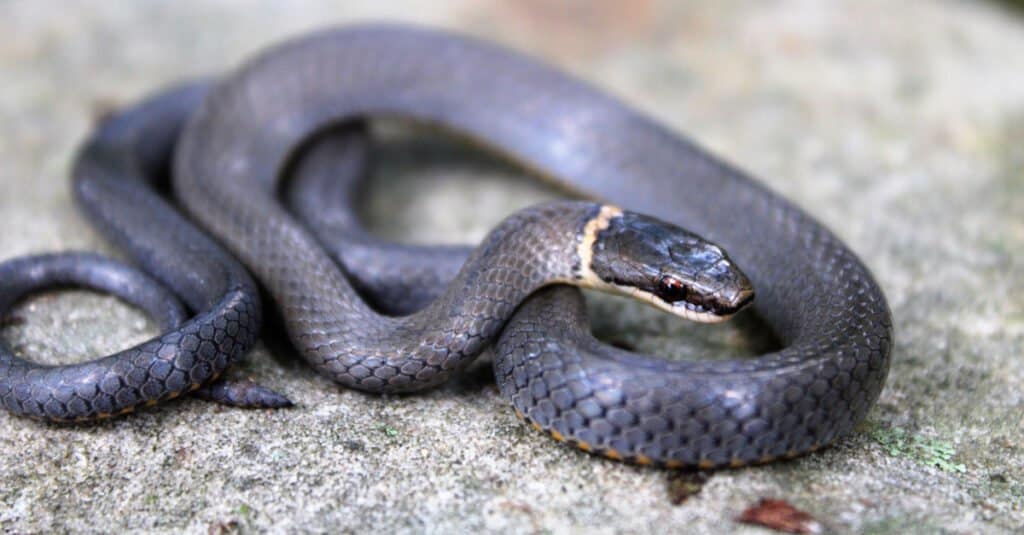
The ring-necked snake is one of the smallest black snakes in Indiana.
©Tucker Heptinstall/Shutterstock.com
Ring-necked snakes are little snakes with a collar-like ring around their neck. They are dark gray or black with bright yellow bellies and a yellowish ring around their neck. At only a foot long, they are one of the smallest snakes in Indiana. They prefer heavily wooded areas and can be found hiding under rocks, logs, and leaf piles. You may find one of these little guys in your garage or basement!
10. Common Garter Snake
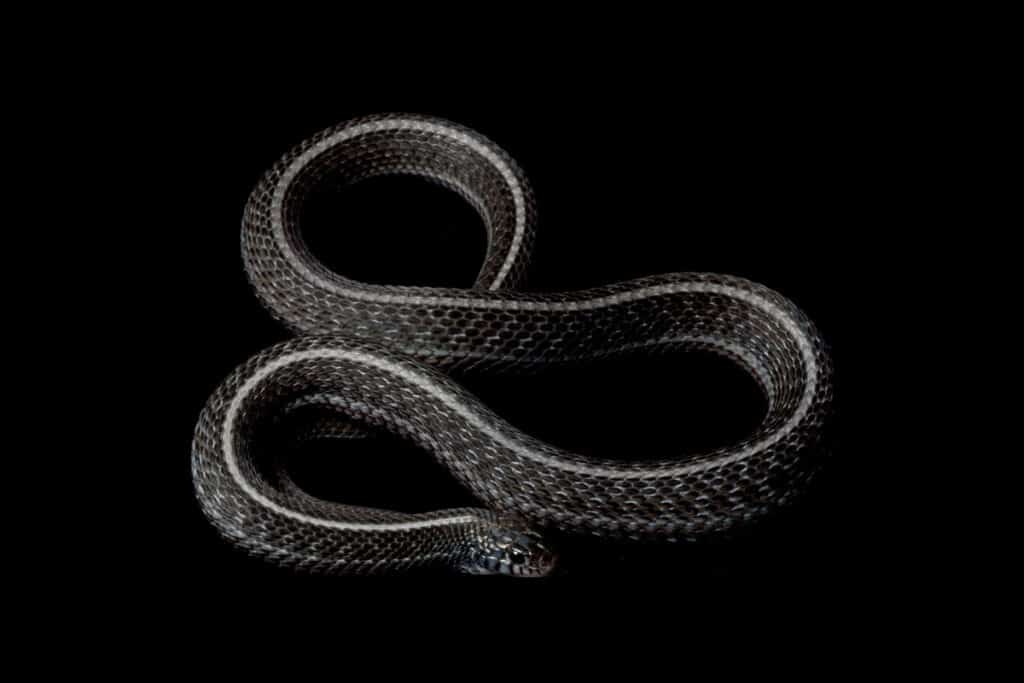
Garter snakes are very common in Indiana. Most have stripes, but some can be all black.
©fivespots/Shutterstock.com
Garter snakes are common in all of the U.S. and found throughout Indiana. Most have long stripes along the length of their bodies, but some lack these stripes and can be all black. Garters that are all black are like that because of melanism, which can occur in other animals as well. This makes their pigmentation darker than usual. The common garter snake, plains garter snake, and Butler’s garter snake are three species of snakes that are found in the state. Most garter snakes are around 3 feet long and are found throughout Indiana. Garter snakes are generalists and can thrive in many different habitats, including your backyard!
Snake Bites in Indiana: Annually
Luckily, snake bites in Indiana are rare and venomous even more so. Around 50 bites a year are reported, mostly from accidental encounters with these well-camouflaged serpents. Heavily-forested areas are often the location of these bites. Keep an eye out when hiking, camping, or enjoying the woods and surrounding lakes.
Brown Snakes in Indiana
In addition to black snakes, brown snakes make up some of Indiana’s 32 snake species. One of the state’s largest snakes is the bullsnake. Bullsnakes are a subspecies of gopher snakes that can reach up to 8 feet long and are colored with big dark brown blotches overlaying a yellow base. They live in sand prairies and can only be found in the northwest of Indiana.
Apart from the cottonmouth and timber rattlesnake, other venomous brown snakes in the Hoosier State include the copperhead and eastern Massasauga rattlesnake. Copperheads are colored light brown with dark brown crossbands in an hourglass pattern and are present in dry forests and high hillside habitats in the south of Indiana. Eastern massasaugas are spotted with big brown or black patches on their backs and smaller spots on their sides. These snakes are located in the north of the state in swamps and wetlands. Read more about brown states in Indiana here.

The bullsnake is one of the brown species of snake present in Indiana.
©Markparker1983/Shutterstock.com
Summary: Black Snakes in Indiana
| Number | Snake |
|---|---|
| 1 | Cottonmouth (Venomous) |
| 2 | Timber rattlesnake (Venomous) |
| 3 | Black kingsnake |
| 4 | Grey ratsnake |
| 5 | Eastern racer |
| 6 | Red-bellied snake |
| 7 | Red-bellied mud snake |
| 8 | Plain-bellied water snake |
| 9 | Ring-necked snake |
| 10 | Common garter snake |
The photo featured at the top of this post is ©
Discover the "Monster" Snake 5X Bigger than an Anaconda
Every day A-Z Animals sends out some of the most incredible facts in the world from our free newsletter. Want to discover the 10 most beautiful snakes in the world, a "snake island" where you're never more than 3 feet from danger, or a "monster" snake 5X larger than an anaconda? Then sign up right now and you'll start receiving our daily newsletter absolutely free.
Thank you for reading! Have some feedback for us? Contact the AZ Animals editorial team.






